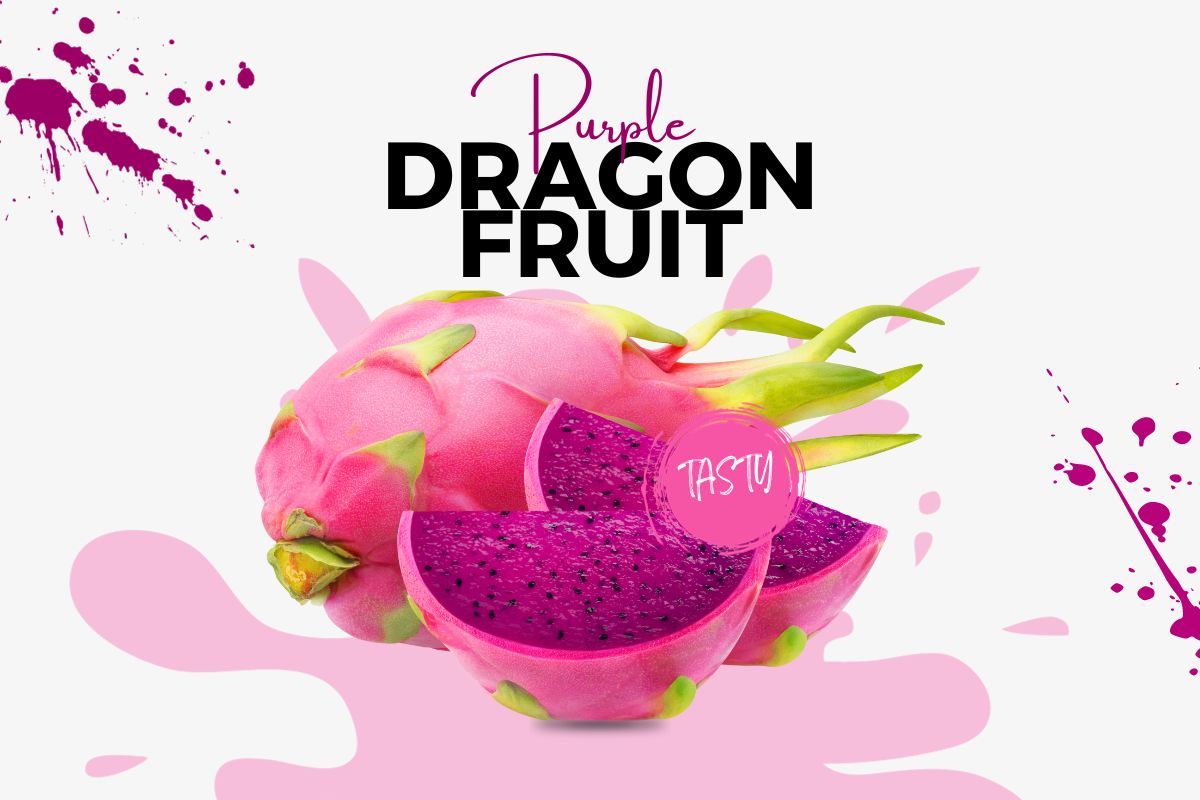Dragon fruit is a unique fruit that not only tastes great but also has many health benefits. While there are several varieties of dragon fruit, one of the most intriguing ones is the purple dragon fruit.
In this article, we’ll delve into the world of purple dragon fruit, compare it to the white dragon fruit, explore its many benefits, understand its growth process, savor its unique taste, and keep an eye on those calorie counts. So, let’s embark on this colorful journey!
Purple Dragon Fruit vs. White Dragon Fruit
First things first, what sets purple dragon fruit apart from its white counterpart? The key differentiator is, unsurprisingly, its color. Purple dragon fruit, scientifically known as Hylocereus costaricensis, boasts a vibrant purple or magenta hue on its exterior.
In contrast, the white dragon fruit, scientifically known as Hylocereus undatus, flaunts a yellow or pinkish skin with white flesh inside.
But why the color distinction? It all comes down to the pigments. Purple dragon fruit’s striking color is primarily due to the presence of betacyanins, a type of antioxidant pigment. These betacyanins not only give the fruit its captivating appearance but also contribute significantly to its health benefits.
White dragon fruit, while still nutritious, lacks the same level of these antioxidants.
Purple Dragon Fruit Benefits
- Antioxidant Powerhouse: As mentioned earlier, purple dragon fruit is rich in betacyanins, which are potent antioxidants. Antioxidants play a crucial role in fighting oxidative stress in the body, which can result in chronic illnesses and premature aging. Therefore, opting for purple foods instead of white ones provides a greater amount of antioxidants to safeguard your cells.
- Skin Health: Those betacyanins in purple dragon fruit can do wonders for your skin. They help fight free radicals that may damage skin cells, potentially promoting a more youthful complexion.
- Heart Health: It contains heart-healthy compounds like fiber and vitamin C. Fiber can help lower cholesterol levels, while vitamin C supports a healthy cardiovascular system.
- Digestive Aid: Both varieties of dragon fruit are fiber-rich, aiding digestion and promoting regular bowel movements. It can help keep your digestive system in tip-top shape.
- Hydration: Dragon fruit comprises approximately 90% water, making it a highly beneficial option for maintaining hydration, particularly in warm environments.
- Weight Management: Dragon fruit is rich in fiber, which may promote a feeling of fullness and satisfaction, potentially leading to a decrease in calorie consumption.
- Vitamin C Boost: Purple dragon fruit, like its white counterpart, is an excellent source of vitamin C. This vitamin is vital for a robust immune system and overall health.
- Rich in Iron: Dragon fruit is known to boost iron levels in the body. Adequate iron is essential for oxygen transport in your blood and overall energy levels.
How Purple Dragon Fruit Is Cultivated
Understanding where this magnificent fruit comes from can deepen your appreciation for it. Purple dragon fruit is a type of cactus, known as a pitaya or pitahaya. Here’s a brief overview of its growth process:
- Climatic Preferences: Purple dragon fruit plant thrives in tropical and subtropical climates. It requires a lot of sunlight and prefers temperatures between 65°F and 95°F (18°C to 35°C).
- The Cactus Connection: These fruits grow on epiphytic cacti, which means they can be cultivated on other plants or trees. This unique growth method is one of the reasons they’re often called “moonlight cacti.”
- Pollination Matters: Dragon fruit plants rely on night-flying creatures like bats and moths for pollination. Once pollinated, the fruits begin to form.
- Harvesting: After several weeks or months (depending on various factors), the fruits are ready to be harvested. They should be picked when fully ripe for the best flavor and nutritional value.
- Sustainability: The cultivation of dragon fruit is relatively sustainable. It requires less water compared to some other fruit crops and can be grown without the excessive use of pesticides.
Savoring Purple Dragon Fruit Taste
Purple dragon fruit‘s appearance may steal the show, but its taste is equally intriguing. Picture a taste combination that combines the pleasant sweetness with a subtle tanginess, similar to a mix of kiwi and pear flavors. The texture is both creamy and crunchy due to the small black seeds speckled throughout the flesh.
The beauty of purple dragon fruit is that it’s not overly sugary, making it a perfect choice for those who prefer subtle sweetness in their fruits. The distinctive taste of this fruit can be savored alone or incorporated into dishes such as fruit salads, smoothie bowls, and desserts for a unique touch.
Purple Dragon Fruit Calories
For those monitoring their calorie consumption, it is worth noting that this type of dragon fruit is a low-calorie option. In fact, it’s impressively low in calories, with approximately 60 calories per 100 grams of flesh. This makes it an excellent choice for those looking to maintain or lose weight while still enjoying a flavorful and nutritious fruit.
The low-calorie count is primarily due to the fruit’s high water content, which contributes to its hydrating properties. Plus, the fiber content helps you feel full, further supporting your weight management goals.
Final Words
Purple dragon fruit stands out not only for its visually stunning appearance but also for its nutritional prowess. Its higher antioxidant content, when compared to the white variety, offers a range of health benefits, from skin rejuvenation to heart health and digestion support.
This tropical delight, cultivated in sunny climates, offers a unique blend of flavors and a low-calorie profile, making it a delicious and guilt-free addition to your diet.
So, the next time you’re at your local market or grocery store and come across these vibrant fruits, don’t hesitate to pick up a purple dragon fruit. Let its mesmerizing appearance and delightful taste transport you to a world of tropical goodness while nourishing your body with its remarkable health benefits.
Tags: purple dragon fruitpurple dragon fruit benefitspurple dragon fruit caloriespurple dragon fruit plantpurple dragon fruit tastepurple dragon fruit vs white

